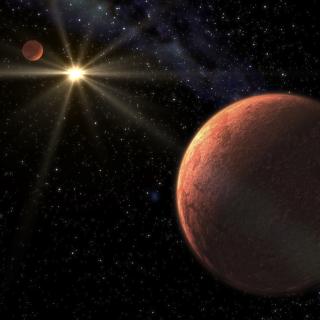Bibcode
Alonso-Floriano, F. J.; Sánchez-López, A.; Snellen, I. A. G.; López-Puertas, M.; Nagel, E.; Amado, P. J.; Bauer, F. F.; Caballero, J. A.; Czesla, S.; Nortmann, L.; Pallé, E.; Salz, M.; Reiners, A.; Ribas, I.; Quirrenbach, A.; Aceituno, J.; Anglada-Escudé, G.; Béjar, V. J. S.; Guenther, E. W.; Henning, T.; Kaminski, A.; Kürster, M.; Lampón, M.; Lara, L. M.; Montes, D.; Morales, J. C.; Tal-Or, L.; Schmitt, J. H. M. M.; Zapatero Osorio, M. R.; Zechmeister, M.
Referencia bibliográfica
Astronomy and Astrophysics, Volume 621, id.A74, 11 pp.
Fecha de publicación:
1
2019
Revista
Número de citas
76
Número de citas referidas
69
Descripción
Aims: We explore the capabilities of CARMENES for characterising
hot-Jupiter atmospheres by targeting multiple water bands, in
particular, those at 1.15 and 1.4 μm. Hubble Space Telescope
observations suggest that this wavelength region is relevant for
distinguishing between hazy and/or cloudy and clear atmospheres.
Methods: We observed one transit of the hot Jupiter HD 189733 b with
CARMENES. Telluric and stellar absorption lines were removed using
SYSREM, which performs a principal component analysis including proper
error propagation. The residual spectra were analysed for water
absorption with cross-correlation techniques using synthetic atmospheric
absorption models. Results: We report a cross-correlation peak at
a signal-to-noise ratio (S/N) of 6.6, revealing the presence of water in
the transmission spectrum of HD 189733 b. The absorption signal appeared
slightly blueshifted at -3.9 ± 1.3 km s-1. We measured
the individual cross-correlation signals of the water bands at 1.15 and
1.4 μm, finding cross-correlation peaks at S/N of 4.9 and 4.4,
respectively. The 1.4 μm feature is consistent with that observed
with the Hubble Space Telescope. Conclusions: The water bands
studied in this work have been mainly observed in a handful of planets
from space. Being able also to detect them individually from the ground
at higher spectral resolution can provide insightful information to
constrain the properties of exoplanet atmospheres. Although the current
multi-band detections can not yet constrain atmospheric haze models for
HD 189733 b, future observations at higher S/N could provide an
alternative way to achieve this aim.
Proyectos relacionados

Estrellas de Baja Masa, Enanas Marrones y Planetas
Se investigan los procesos que conducen a la formación de estrellas de baja masa, enanas marrones y exoplanetas y caracterizar las propiedades físicas de estos astros en varias etapas evolutivas. Las estrellas de muy baja masa y las enanas marrones son probablemente los objetos más numerosos de nuestra Galaxia, pero no por ello están
Rafael
Rebolo López

Exoplanetas y Astrobiología
La búsqueda de vida en el Universo se ha visto impulsada por los recientes descubrimientos de planetas alrededor de otras estrellas (los llamados exoplanetas), convirtiéndose en uno de los campos más activos dentro de la Astrofísica moderna. En los últimos años los descubrimientos cada vez más numerosos de nuevos exoplanetas y los últimos avances
Enric
Pallé Bago